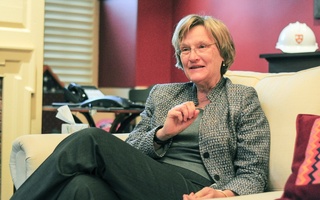To the editor:
In the January 19th article, “In Debate Over Names, History and Race Relations Collide,” University President Drew G. Faust is quoted making a number of arguments against renaming buildings and removing symbols across the University which serve to exalt the legacies of slaveholders and traders.
First, her assertion that removal of these names and symbols is somehow tantamount to “erasing” Harvard history is both intellectually lazy and transparently hypocritical. Not too long ago, given the long history of the College, Pforzheimer House was called North House, on a part of the campus which, not too long before that, was a part of Radcliffe College before Harvard admitted women. Things change at Harvard with an unrelenting alacrity, provided only that the skids of those changes are greased with capital. It is pointless and insulting for the President to conflate commercial interests with moral imperatives in this way. For $500 million, Mather House would be renamed The Huey P. Newton Palace of Negro Excellence over winter break. And, of course, the fact that the institution of slavery, which was perpetuated by the namesakes of these buildings, resulted in the actual erasure of generations of black names, family bonds, and cultural ties adds an almost laughably ironic context to her comments.
But what motivated this letter was not President Faust’s failure to frankly address the mercenary realities of how buildings and things get named at Harvard—which is, after all, obvious to everyone. Instead, I was struck by her callous assertion that by passing through each day, and sleeping every night, in buildings named for those who participated in, promoted, and perpetuated chattel slavery, a benefit redounds to black students at Harvard. Specifically, by creating an environment that “… demands enough resilience so as not to require special provisions of safety in the long term ....” This is a truly breathtaking statement.
As 2014’s "I, Too, Am Harvard" campaign clearly showed, black students are not lacking for opportunities to build resilience. To be black and Crimson is to be presented with an unending stream of demands on our capacity for resilience, such that the threat is not that we lose the capacity from lack of use, but rather, that resilience, along with patience, becomes a depleted resource. In fact, President Faust might, instead, consider whether it is unfair to deprive white Harvard students similar pathways to personal growth. Perhaps she should turn her munificent gaze towards them. By removing some of the most glaring indicia of white supremacy from campus, Harvard could actually help to develop resilience in a portion of its student population most in need of that particular attribute, as the demographics of the country—if not, alas, at Harvard—inexorably change.
Kimberly Williams ’95, founder and CEO of RedShift Legal, is a former resident of Kirkland House.
Read more in Opinion
The Secular Life at HarvardRecommended Articles
-
Altruism Amid AnguishThe unity with which our communities confronted this week’s happenings deserves credit and praise. Police officers, emergency personnel, and the people of Boston have demonstrated incredible resilience and strength—a true cause for celebration
-
Simple Acting Skills that Can Change Your Life: Part 2Just as actors remain resilient through difficulty, even incorporating their adversities and triumphs into their work, others can do the same and “keep on keeping on” despite all odds.
-
 In Debate Over Names, History and Race Relations Collide
In Debate Over Names, History and Race Relations Collide -
Climate Change Comes to CambridgeRising sea levels, storm surges, and floods caused by climate change could place Harvard's campus at risk of being washed away.
-
 Men's Water Polo Caps Season with Deep Postseason Run
Men's Water Polo Caps Season with Deep Postseason Run













